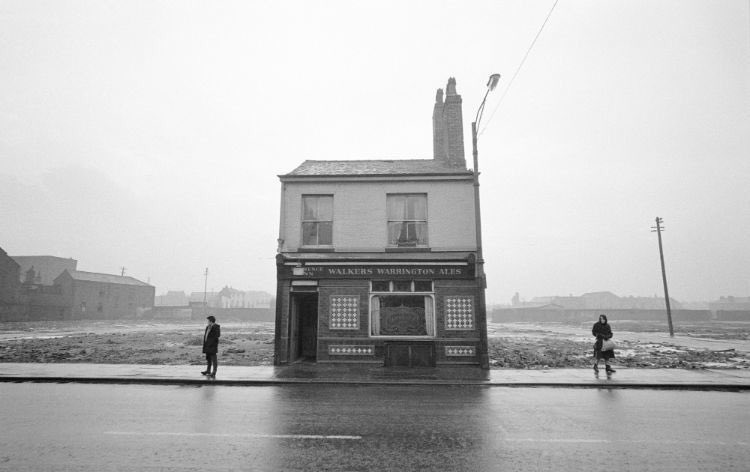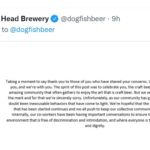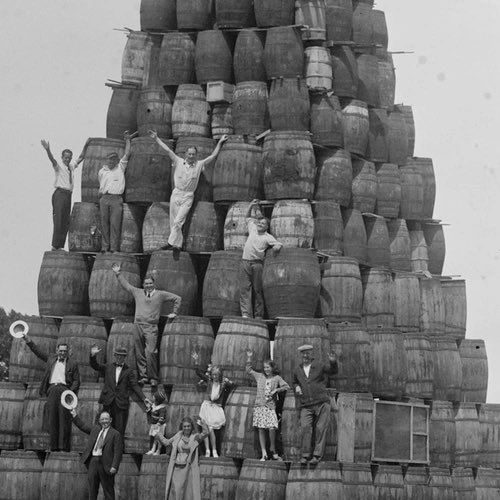Where to begin? It’s been a good week in my hometown. CHeery even. The summer is lingering and the backyard crop of tomatoes and grapes has been coming in. Eighteen months in, it is one of the most normal weeks so far even if we see elsewhere things are returning to other more difficult norms. I was reminded of even a third norm by the wonderful image above of the lonely pub by John Bulmer from 1964 that passed by on social media this week. Lovely and evocative. It reminded me of me. Or at least mine. That empty space? Space like that was where my people lived. Or did before they move up and/or away. This norm of today shall also pass.
Update! Lisa Grimm on new bad stouts in Ireland:
…with Heineken recently releasing Island’s Edge, and Guinness rolling out their new Guinness 0.0. Island’s Edge has been expressly positioned as a stout for people who don’t typically drink stout, and to that end, it includes tea and basil in the recipe to make it, to paraphrase, less bitter and more refreshing, though none of the flavours of tea or basil are noticeable in the resulting beer. So, having had a pint of it recently, I can confirm that it does, indeed, lack those flavours…along with most other elements of flavour.
![]() Next, I had to grab a screen shot of this image to the left from Stan‘s weekly round up. You can open it in a new tab for the full size. It’s super tiny because it’s a huge image from the Craft Brewers Conference on an
Next, I had to grab a screen shot of this image to the left from Stan‘s weekly round up. You can open it in a new tab for the full size. It’s super tiny because it’s a huge image from the Craft Brewers Conference on an indoctrination education session on lager brewing. These images always make me scratch my head year after year. It was all about hazy beer education a few years ago and massive barrel ales a few years before that. Beyond clubby. Chasing the tail in lock step with every other brewery in attendance. That once again is the business plan for these fiercely independent and sometimes off center breweries. That’s weird.
The same idea is bouncing about in Kate Bernot‘s excellent, subtle and perhaps surreptitious piece on Oregon’s Full Sail Brewing’s perhaps last chance effort to regain some reputation in the craft beer marketplace. The plan? A fantasy of chasing and copying Boston Beer’s now decade or more and well established run as far away from actual beer as possible. There are three references spread across the article to that strategy. It’s like a plan to marry rich. Plus look at this:
… Full Sail’s beers weren’t being placed on shelves in desirable places, primarily because low prices on the Session line of beers led them to be shelved next to light beers, while the drinker Full Sail wants to attract might only be shopping in the craft section… To correct this, Full Sail raised prices on June 1 on most of its beers by a couple dollars per pack to bring them more in line with other regional and national craft breweries. Though it goes against the laws of supply and demand, the switch led to an +11.5% boost in sales on Session beer in Oregon and Washington markets three months after the price change… Tiernan says part of the boost for Session is shelf placement next to other craft breweries, and part of it is a more strategic approach to the idea of “value.”
Entirely anti-beer consumer initiatives like that might be described as the “premiumization of old craft”… or perhaps lipstick on a pig. Time will tell if the bait and switch has a lasting effect with the beer buying public. It’s probably far too late. As Jeff on the ground both tweeted and was quoted: “I suppose a few folks are still kicking around who feel warmly about [Full Sail], but not many…” Dead cat bounce?*
Ian McKellen helps out on quiz nights at his pub.
There was an interesting hour of radio provided by the CBC’s new season of Tapestry and its interview of Edward Slingerland, academic and author of Drunk: How We Sipped, Danced, and Stumbled Our Way to Civilization. He also confirms or at least bolsters my suspicions or at least speculations that alcohol pre-dates community discussed here four years ago.
…in the standard account, alcohol’s this kind of byproduct of agriculture, and it happened after agriculture. But once I started doing the research for the book, if you dig into the archaeological record, what it looks like is hunter-gatherers were making alcohol in a serious way, way before agriculture. Probably this goes back 20,000 years or so, but we certainly have direct evidence 13,000 years ago that people were making beer in what’s now Israel. And then we have sites like the site in Turkey called Göbekli Tepe, where hunter-gatherers — this site’s probably 12,000 years old — were coming together, building these massive ritual complexes.
He does unfortunately use the word “myth” to describe the idea how alcohol makes people aggressive suggesting those people were already aggressive before describing how alcohol just dampens control. That, to me, is describing removing the guard against bad behaviour that would otherwise be left in place. Odd argument. Also uses “neo-prohibition” while advocating for measured control. As in temperance. Which is pretty close to what people mean by “neo-prohibition”…But a good listen nonetheless.
Question: is Matt suggesting that Boursin spreadable cheeses are his perfect hangover cure?
Ron shared a few thoughts on him being compulsive which he believes is the basis for his success as a beer historian:
I realise my head isn’t like everyone else’s. Compulsive behaviour. It’s part of me. When I looked out of my office window and saw someone touching every sign along the road, I didn’t think “What a weirdo”. No. That’s just like me, I thought. A bit more public and odder looking, but basically just like me. Being compulsive has its advantages as a researcher. It means I go through material fully. Really fully. Whenever I see beer analyses or price lists, I have to record them. It’s a pain in the arse, quite a lot of work, but I can’t help myself. Thirty years of such compulsive behaviour has left me with some amazing datasets.
Mostly unrelated, making beer can sometimes remind me of the consequences of drinking beer.
Finally, this quotation from the CBC and Dr. J Nikol Jackson-Beckham gave me pause:
“If you weed out a bad actor but do not change the culture, when the next bad actor comes along, they will thrive in the same environment.” Dr. J, “The unthinkable has happened, finding your way after harassment, discrimination, or abuse has changed everything.”
I paused for the message itself as well as the long haul Dr J. is on. I wrote about her thoughts in 2017 in a post titled “Peter Pan As Craft Beer’s Archetype” and it may well be that not much has changed. Fight!
That’s it. As you start at the bottom of the glass or at the floor before you, for more check out the updates from Boak and Bailey mostly every Saturday and from Stan now apparently a regular again every Monday, plus more with the weekly Beer Ladies Podcast, at the weekly OCBG Podcast on Tuesday (the talk was of awards this week) and sometimes on a Friday posts at The Fizz as well. There is a monthly sort of round up at The Glass. There is more from the DaftAboutCraft podcast, too. And the Beervana podcast. And sign up for Katie’s weekly newsletter, The Gulp, too. And check out the Atlantic Canada Beer Blog‘s weekly roundup. Plus follow the venerable Full Pint podcast. And Fermentation Radio with Emma Inch. The AfroBeerChick podcast as well! And also look at Brewsround and Cabin Fever. And Ben has his own podcast, Beer and Badword – when he isn’t in hiatus as at the mo, more like timeout for rudeness! And remember BeerEdge, too, and The Moon Under Water.
*Investment concept referring to a late final brief upturn of a plummeting stock. Refers to the fact that even a dead cat will bounce on the sidewalk if dropped from great enough a height. Not sure this is actually true but the image is effective.













